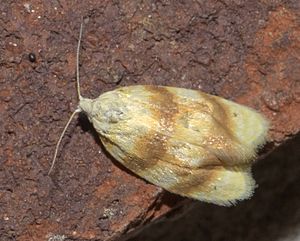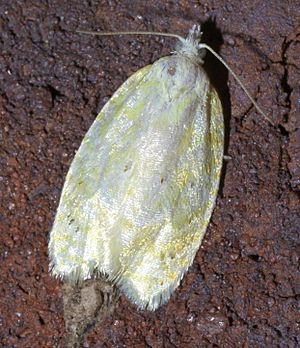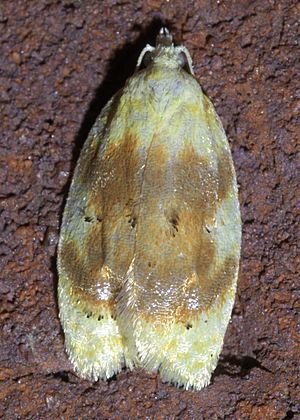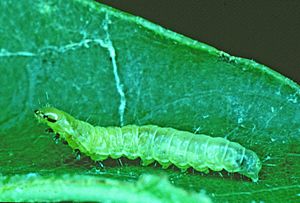Oak leaftier moth facts for kids
Quick facts for kids Oak leaftier moth |
|
|---|---|
 |
|
| Scientific classification | |
| Synonyms | |
|
The oak leaftier moth (scientific name: Acleris semipurpurana) is a small moth from the family Tortricidae. It's called an "oak leaftier" because its young, called larvae or caterpillars, tie oak leaves together with silk.
These caterpillars eat the leaves of oak trees in the Eastern United States and southeastern Canada. They can cause a lot of leaves to be eaten, which is called defoliation. Losing too many leaves can harm or even kill oak trees, especially red oaks.
Adult moths lay single eggs on oak tree branches in June. These eggs stay on the branches all winter. They hatch the next April. The larvae eat tree buds and young leaves. Then, they tie leaves together with silk to create a safe place to live and eat. In May or June, they change into pupae in the leaf litter on the ground. After a week or two, adult moths come out. They mate and lay the next generation of eggs.
Contents
Life Cycle of the Oak Leaftier Moth
Oak leaftier moths lay their eggs in June each year. They usually lay one egg at a time on rough twigs, often on branches that are two years old. The eggs stay on the branches through the winter, a process called overwintering. They hatch in the spring of the next year.
From Larva to Pupa
The larvae, also known as caterpillars, come out in April. At first, they eat the buds of oak trees and the young leaves inside them. When they are fully grown, the larvae are about 12 millimetres (0.47 in) long. They are a "dirty white to light green" color. They have a pale brown head and front legs that are black or brown.
Other ways to identify the larvae include a long head with a black mark on their cheek area. They also have brown legs on their thorax, which is the middle part of their body. The larvae tie leaves together using silk. This is how the moth got its common name. The larvae live and eat inside these tied or folded leaves. They stay there until they are ready to change into a pupa in mid to late May.
Adult Moths Emerge
When it's time to change, the larvae leave the trees to become pupae. They drop to the ground using silken threads. You can often find the pupae in the leaf litter on the forest floor under the oak trees. After one or two weeks as a pupa, the adult moths come out in late May or June.
The adult moths are small, with a wingspan of about 12 millimetres (0.47 in). Their wings have a special bell shape. The color of their wings can be very different from one moth to another. Some moths have yellow front wings, while others have dark brown or even purple marks. The adult moths mate and lay eggs. Only one group of moths is produced each year. The Acleris semipurpurana moth was first described by William D. Kearfott in 1909.
Where Oak Leaftier Moths Live and Their Impact
The Acleris semipurpurana moth lives in the eastern United States and parts of southeastern Canada. They have been found in states like New York, Massachusetts, Connecticut, and Pennsylvania in the northeast. They also live as far west as Minnesota and Texas. In Canada, they are found in Ontario.
These oak leaftier moths mainly eat the leaves of red oak trees. This includes trees like eastern black oak, northern red oak, pin oak, scarlet oak, and scrub oak. Many different kinds of moths are called "oak leaftier," but Acleris semipurpurana is the most common and causes the most defoliation. Other insect pests, like Archips semiferanus, also often feed on the same oak trees.
Damage to Oak Trees
The young larvae eat the tree buds. This can destroy new leaves or cause them to grow with many holes. This uses up a lot of the tree's stored food. Older larvae can eat almost all the remaining leaves, causing the tree to lose most of its foliage. When trees lose their leaves for two or more years in a row, it can lead to branches dying. The tree also grows less in width and becomes weaker.
The oak leaftier has caused many trees to die, especially in the Appalachian Mountains region. When trees are weakened or die, fungi like the shoestring root fungus and wood-boring insects like the twolined chestnut borer can attack them. A large outbreak of these moths happened in the 1960s and 1970s. It affected areas in Connecticut, Massachusetts, New York, Pennsylvania, Virginia, and West Virginia. Tiadaghton State Forest in north central Pennsylvania was hit especially hard.
Usually, natural ways of controlling pests, like other insects that eat the moths, are enough to keep the Croesia semipurpurana population in check. However, sometimes pesticides are needed to help protect the trees.





